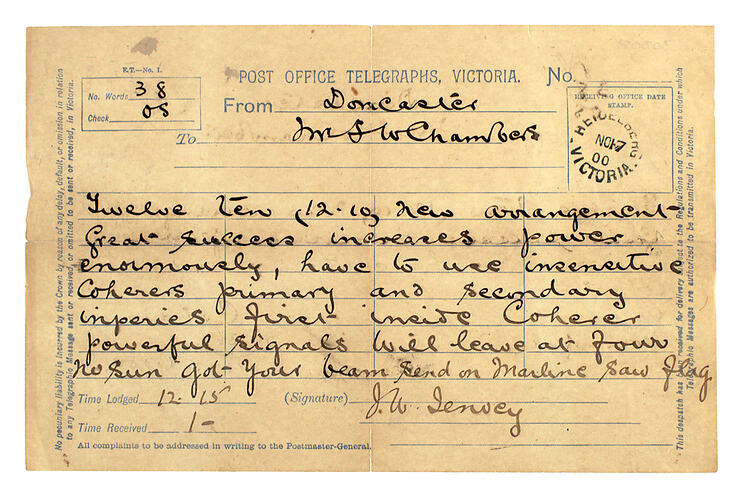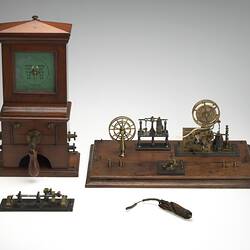Summary
Telegram sent by J.W. [or H.W.?] Jenvey from Doncaster to F.W. [or S.W.?] Chambers giving information about wireless transmission experiments.
The telegram was lodged for transmission at Doncaster Post Office at 12:15 pm on 17th November 1900, and was received at Heidelberg Post Office at 1 pm. The message is addressed to a Mr F.W. (or S.W.?) Chambers and refers to the use of Coherers, a type of radio wave detector used in early wireless telegraphy pioneered by the Italian inventor, Guglielmo Marconi. The signature for the sender appears to read 'J.W. Jenvey', however, it seems likely that the sender was Henry Walter Jenvey, Telegraph Engineer and Chief Electrician with the Postmaster-General's Department, who pioneered the use of wireless telegraphy in Victoria, conducting a number of experiements in 1900-1901 culminating in the transmission of a message of welcome from Queenscliff to the Royal Yacht 'Ophir' on its arrival in Melbourne for the opening of the first Federal Parliament in May 1901.
The recipient is believed to have been Francis West Chambers, Chief Electrician with the Victorian Public Works Department, who collaborated with H.W. Jenvey in his early wireless telegraphy experiments. In a lecture on Wireless Telegraphy presented to the Heidelberg branch of the A.N.A., on Thursday 16th May 1901, F.W. Chambers stated that "he had conducted a number of experiments from his residence on Mount Eagle, Heidelberg, to the Doncaster Tower, a distance of 4¾ miles, and they had been completely successful." [Mercury & Weekly Courier, 17 May 1901] Another earlier report refers to wireless telegraphy messages having been transmitted by Jenvey "between the General Post-office and Heidelberg (eight miles), Doncaster and Heidelbeig (four miles)" [Portland Guardian, 17 April 1901]. It seems likely that F.W. Chambers was involved in both experiments.
Physical Description
Standard Post Office telegram form with handwritten message signed by J. W. Jenvey.
More Information
-
Collection Names
-
Collecting Areas
-
Acquisition Information
Unknown Acquisition Method from Unknown Source
-
Postmarked
Heidelberg, Greater Melbourne, Victoria, Australia, 17 Nov 1900
-
Sender (Probable)
Mr Henry W. Jenvey - Postmaster-General's Department, Doncaster, Greater Melbourne, Victoria, Australia, 17 Nov 1900
Although the telegraph is marked as "(Signature) J.W. Jenvey", this is clearly written by the telegraph operator or clerk at the receiving end and may be an error in transmission or recording. Circumstantial evidence suggests that the telegram was sent by H.W. Jenvey, a pioneer of wireless telegraphy in Victoria. -
Recipient
Mr F.W. Chambers, Heidelberg, Greater Melbourne, Victoria, Australia, 17 Nov 1900
-
Inscriptions
Handwritten message: From "Doncaster" To "Mr FW [or SW?] Chambers" "Twelve ten (12.10) new arrangement Great Success increases power enormously, have to use insensitive Coherers primary and secondary inperies [Illegible] first inside Coherer powerful signals Will leave at four no sun got your beam send on Machine saw flag" Time Lodged "12.15" (Signature) "J. W. Jenvey" Time Received "1- " Postmark stamp "HEIDELBERG / NO17 / 00 / VICTORIA"
-
Classification
-
Category
-
Discipline
-
Type of item
-
Overall Dimensions
223 mm (Length), 140 mm (Width)
-
References
"Lecture on Wireless Telegraphy", Mercury & Weekly Courier, 17 May 1901, p.2, [Link 1] "Wireless Telegraphy", Portland Guardian, 17 April 1901, p.3, [Link 2]
-
Keywords
Coherers, Communications, Innovations, Radio Broadcasting, Radio Receivers, Telegrams, Wireless Telegraphy


